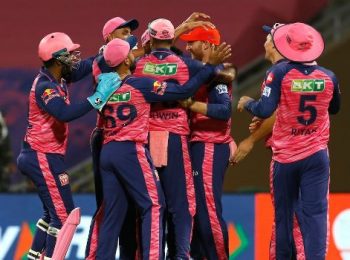The Leeds Test between India and England was a magical Test match, one that truly warmed the hearts of those who cherish the longest format of the game.
From an English perspective, it embodied everything they’ve been working towards. Their approach wasn’t reckless, nor was it timid, it was a more evolved version of Bazball: smart, measured, and precise.
With any bold strategy like Bazball, you often swing too far in one direction at first. England have had their moments of over-aggression, but what we saw here was a matured, fine tuned version of that philosophy. It was efficient, balanced, and repeatable—the kind of cricket that can be sustained, and that can win consistently.
And that’s what’s truly exciting from an English perspective, it didn’t feel like a one-off. Yes, it was a massive run chase—one of the highest in England’s Test history, possibly the fourth-biggest in the fourth innings. The numbers speak for themselves. But beyond the stats, what stood out was the sense that this is becoming repeatable.
There was a composure and authority to the way England approached the chase, even against an attack that included the best bowler in the world—who, remarkably, was blunted to a significant degree.
And while comparisons may be tempting, it’s unfair to draw parallels between Ben Stokes and someone like Shubman Gill in this context—the leadership, the pressure, the moment—Stokes just operates on a different plane right now.
Shubman Gill is clearly still learning the ropes and finding his footing as a leader. In contrast, Stokes is a seasoned international captain, so drawing direct comparisons at this stage is a bit unfair. That said, captaining India for the first time is no small task, and it comes with immense pressure. One thing I would have liked to seen Shreyas Iyer in the squad—not just for his batting, but for the added leadership value he brings. Having a strong leadership group around a young captain like Gill could make a big difference, giving him experienced shoulders to lean on during crucial moments.
When I look at India right now, it feels like a team in transition. A few senior, iconic players have stepped away from Test cricket, and a younger crop is finding its rhythm. Within that
evolving leadership group, I sometimes get the sense that Shubman Gill could use a bit more support out there on the field.
That’s why the absence of someone like Shreyas Iyer surprised me—not just because of his batting credentials, but also the leadership qualities he brings. He could offer vital on field guidance and act as a steady presence alongside Gill.
But shifting focus back to England for a moment—some of the innings we witnessed were absolutely sublime. There have been some really smart decisions made by England. Take the Ben Duckett-Zak Crawley opening pair, for instance. Sure, Crawley has his critics— especially when the runs aren’t flowing—but he’s quietly built a strong case. A century in the last Test, and here, a composed half-century that laid the foundation.
You can’t underestimate the value of that final session on day four. They ended the day at 40 without loss, batting through a crucial period under pressure. That stand was pivotal—it gave England the platform and belief to chase down the target on day five. Crawley’s fifty may not have been headline-grabbing, but it was significant—a knock that truly mattered in the context of the match.
In fact, Crawley’s innings had a greater impact than the numbers alone would suggest.
From India’s point of view, one of the big concerns going forward is Joe Root. Yes, he scored a calm, match-sealing half-century here—but it’s clear he’s just getting started. You can expect him to play an even bigger role across the remaining four Tests.
Looking at India more closely, I felt the conditions at the start of the match were actually more favorable for batting. But it seemed both sides misread the surface—they expected more assistance than it offered early on. And that’s why, even before the match began, I
believed India had to play Kuldeep Yadav. His variation and control could’ve made a crucial difference on a pitch like this.
India have to play Kuldeep if there’s even the slightest chance he can influence the game— and the final innings of this Test proved exactly why. There may not have been dramatic turn on offer, but there was just enough in the pitch to trouble batters. Had Kuldeep been operating at his best, chasing that target would have been significantly harder for England. I’m not saying they wouldn’t have done it, but it certainly wouldn’t have been as smooth.
As we head into the next Test in Birmingham, India must seriously consider bringing him in—especially with the weather drying out and a heatwave setting in. The conditions are likely to get more spin-friendly, and Kuldeep could be the X-factor they’re missing.
The real balancing act for England at the toss lies in recognizing where their current strength lies, especially in the absence of key pacers like Jofra Archer, Mark Wood, and Gus Atkinson. Right now, it’s clearly their batting that’s holding the side together. The good news is that Archer is back for the next Test.
Ideally, they should have batted first to play to that strength, but even batting last isn’t a disaster. With the depth and form they have, they’re far more likely to win matches with the bat than with the ball at the moment. That will be a key consideration for both teams heading into the next Test—how to align their decisions with where their real edge lies.
And as for Rishabh Pant, what an astonishing talent. Absolutely breathtaking in what he brings to the game. This Test had everything, entertainment and substance in equal measure. We witnessed two centuries of exceptional quality, true Test match gems.
India’s batting line-up, though still evolving with some fresh faces, will take immense learning from this game. Players like Sai Sudharsan showed promise, while others—like Karun Nair—aren’t newcomers, but are working their way back into the side.
Gill’s century, particularly under the pressure of captaining for the first time, was monumental. It was a defining knock, not just for him personally, but for the team’s belief in his leadership. And there were plenty of other positives too—KL Rahul’s form, Rishabh Pant’s excellent innings and Jaiswal’s contribution—it all adds up to a solid foundation for the series ahead.
When it comes to playing in England, the biggest challenge for visiting teams is usually adapting to the conditions. Likewise, when England tour India, their biggest hurdle has historically been getting their batters to score consistently on turning tracks. In this match, I thought India’s batters handled English conditions brilliantly—that’s not in question. The real concern lies with their bowling attack, which lacked the cutting edge and penetration needed to truly trouble England’s lineup. This is where India will need to sharpen up if they want to swing the momentum in the upcoming Tests. And this is precisely where India need to consider making a change—possibly bringing in Kuldeep. But beyond that, their biggest issue is finding the right balance in the playing XI.
In this match, they were blown away far too easily once the top order was gone—the last five or six wickets fell quickly, and those missed runs proved to be vital.
India now need to take a hard look at their team composition. They can’t afford to be distracted by just the batting collapse. Instead, the focus should be on overall balance—
ensuring they have both the depth in batting and enough firepower in the bowling to control the game when it matters most.
For me, India’s top priority has to be building a bowling attack capable of taking 20 wickets. If they want to win, they must find a way to bowl England out twice—that’s non-negotiable. The next Test squad needs to reflect that intent: an incisive, aggressive bowling unit that can apply real pressure.
Their batting, on the other hand, should hold up. The top order is in decent form, and the top five or six need to shoulder the responsibility. Jadeja, in particular, must step up with the bat—India need more from him in that department.
India’s bowlers need to carry the bulk of the load—there’s no room for compromise there. If they go with a bits-and-pieces attack, I just don’t see it being enough to seriously challenge or disrupt this confident England side.
That’s my key takeaway moving forward: India have plenty of positives to build on—plenty. But sharpening their bowling strategy will be crucial.
And with the series so finely poised, it sets the stage beautifully for what promises to be four truly fascinating Test matches ahead.



























